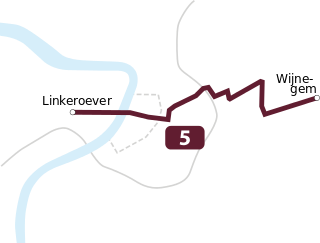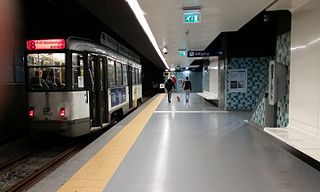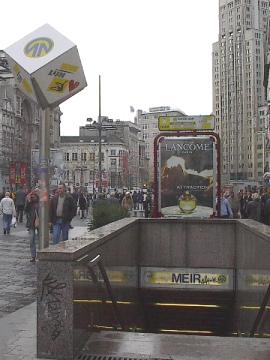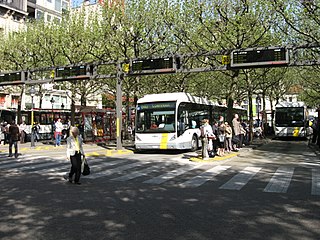
The HSL 4 is a Belgian high-speed rail line part of the 87 kilometres (54 mi) axis which connects Antwerp to the Dutch border. It is 40 kilometres (25 mi); 36 kilometres (22 mi) of it being dedicated high speed tracks. It was scheduled for completion by 2005 and opened in 2009.

The Antwerp premetro tram route 3 is a tram route connecting Merksem with Melsele in the city of Antwerp. The route is operated by the Flemish transport company De Lijn and historically also by its Antwerp predecessor, MIVA.

Antwerp is a city and a municipality in the Flemish Region of Belgium. It is the capital and largest city of Antwerp Province, and the third largest city in Belgium by area at 204.51 km2 (78.96 sq mi) after Tournai and Couvin. With a population of 536,079, it is the most populous municipality in Belgium, and with a metropolitan population of over 1.2 million people, the country's second-largest metropolitan area after Brussels.

Plantin premetro station is an Antwerp premetro station. Located under the intersection of Simonsstraat with the Plantin en Moretuslei, it is served by lines 2, 6, 9 and 15.

Tram route 5 is a tram route in Antwerp running from Linkeroever to Wijnegem that is operated by the Flemish transport company De Lijn. The modern route was put into service on March 4, 2006, initially connecting Linkeroever with Deurne. The tram route uses the Antwerp pre-metro between the stations Van Eeden and Schijnpoort. On April 14, it was extended from the Wim Saerensplein in Deurne to the Wijnegem Fortveld terminus.
Tram route 8 is a tram route in Antwerp and nearby Wommelgem. The present day route was opened on 8 December 2019 connecting the Astrid premetro station with the Wommelgem Roundabout P+R. The route was the first to use the newly opened premetro tunnel under Borgerhout, called the Reuzenpijp, which begins at Astrid station and comes above ground just before the Muggenberg stop. It is promoted as a "fast tram" (sneltram) route, as most stations in the premetro tunnel have not (yet) been opened, allowing a 15-minute connection between the city center and the Wommelgem P+R.

Tram route 6 is a tram route in Antwerp between the Metropolis P+R in the northern Luchtbal suburb and the Olympiade P+R in the southern Kiel neighborhood, using the pre-metro network between stations Sport and Plantin. The route was officially opened on 27 October 2007 and is operated by the Flemish transport company De Lijn.

Zegel is a station on the Antwerp premetro network, opened on 18 April 2015. It lies under the Turnhoutsebaan near the crossing with the Sint-Jansstraat, in the Borgerhout district and is served by tram routes 8 and 10.

Opera is a station in the Antwerp premetro network, lying under the Leien near the Teniersplaats in the city centre. The station was opened on 25 March 1975 along with the initial opening of the Antwerp premetro network. The station was temporarily closed in 2016 in order to undergo a full renovation and expansion and reopened in its current form on 8 December 2019. The station lies in the immediate proximity of the Antwerp opera building and is a part of the central east-west premetro axis. It is served by the tram routes 3, 5, 9, 10 and 15.

Astrid is a station in the Antwerp premetro network that was opened on April 1, 1996. The station lies directly under the Koningin Astridplein on the Gemeentestraat side. The station is one of the two premetro stations in Antwerp servicing passengers from Antwerp Central Station, the other being Diamant, which lies to the south of Astrid. It is served by tram lines 8 and 10. Line 8 terminate in this station.

Sport is an underground station in the Antwerp premetro network. The station was opened on April 1, 1996 as the last station on the northern premetro axis. At present, the station is served by tram routes 2, 3 and 6. Tram route 5 also passes through the northern premetro axis, but leaves the premetro tunnel via the Ten Eekhovelei exit between Schijnpoort and Sport. It does not stop at the Sport station, but has a stop called "Sportpaleis" at the Ten Eekhovelei.

Frederik van Eeden is an underground station in the Antwerp premetro network located in the Linkeroever suburb on the left bank of the river Scheldt. The station was opened on 21 September 1990, the same time as the Brabotunnel, linking the station with Groenplaats station and allowing trams in the premetro network to cross the river Scheldt. The station is located directly underneath the F. Van Eedenplein, named after the writer of the same name.

Meir is a station in the Antwerp premetro which opened on 23 March 1975. The station is located directly underneath the street Meir, after which it is named.

Tram route 9 is a route in the Antwerp tram network connecting the Eksterlaar neighborhood in southern Deurne with Linkeroever using the Antwerp premetro network between Plantin and Van Eeden stations. The present day route was officially opened on September 1, 2012, as part of a revision of the network map.

Schijnpoort is an underground station in the Antwerp premetro network. The station was named after the Schijnpoort gate, part of the Brialmont fortifications, which was demolished in 1970 when constructing the R1 ring road. It was opened in 1996 as part of the northern premetro axis and was originally only served by tram route 3. Currently, it is also serviced by tram route 5, tram route 6 and tram route 2.

Tram route 11 is an above ground tram route in the city of Antwerp, Belgium. It currently runs between the Antwerpen-Berchem railway station and the Melkmarkt in the city centre.

The Franklin Rooseveltplaats is a large square in the city of Antwerp, Belgium, placed at the crossing of the Leien and Turnhoutsebaan, and within walking distance of the Koningin Astridplein and Antwerp-Central station. The square functions primarily as the main bus station in Antwerp, which with its 28 platforms handles a large part of all bus transport in the city, as well as several tram routes.

Diamant premetro station is an Antwerp Premetro station. Located under the Pelikaanstraat and next to Antwerp Central Station, it is served by lines 2, 6, 9 and 15.

Groenplaats premetro station is an Antwerp premetro station. Located underneath the Groenplaats, it is served by lines 3, 5, 9 and 15.
Tram Route 10 is a tram route in Antwerp and nearby Wijnegem. Tram route 10 entered operation in 1873, making it one of the oldest tram routes still active in Antwerp, next to Tram Route 4 (Antwerp) and Tram Route 7 (Antwerp).
























